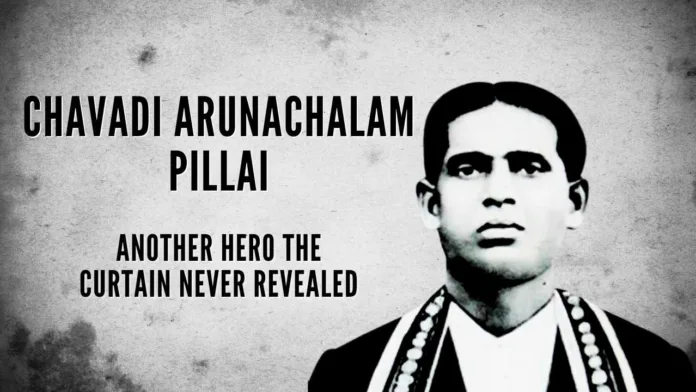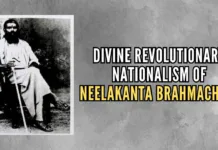
Remembering freedom fighter Arunachalam Pillai, whom most of us Bharatiyas don’t know about
Bharata’s Freedom Struggle was a blockbuster movie with an ensemble cast whose screenplay was rewritten by the reviewers and passed off as one propelled by a few superstars.
Chavadi Arunachalam Pillai was one of the main characters in the famous Tirunelveli Conspiracy Case 1911, whom most of us Bharatiyas don’t know about. He was one of the closest friends and associates of Veera Vanchinathan, who shot and killed Robert William d’Escourt Ashe, the district magistrate of Tirunelveli in the Maniyachi railway station. A few accounts identify Arunachalam Pillai as Vanchi’s backup, who ran across the railway tracks and escaped once Vanchi hit his target. It is another story that Arunachalam Pillai was eventually acquitted after a gruelling and torturous 237 days in incarceration.
Chavadi Arunachalam Pillai was born into an affluent family to Chavadi Subramania Pillai and his second wife, Smt. Swarnammal in 1893 in Shenkottah. After finishing his schooling in Shenkottah, he was awaiting admission to Calcutta Medical College when the Ashe murder played out.
Neelakanta Brahmachari played the role of wandering Pracharak of Swarajya very well. He acted as a glue that brought people from various walks of society under the umbrella of Bharata Mata Sangham. Bharata Mata Sangham was particularly active in South India, especially after the arrest of V O Chidambaram Pillai, Subramanya Sivam, and Padmanabha Ayyangar by the then Collector of Tirunelveli, Winch, on March 12, 1908.
If Neelakanta Brahmachari was the force from the outside, Veera Vanchinathan was the aggregator from the inside. He helped recruit new members for the Bharata Mata Sangham across his region. Chavadi Arunachalam Pillai was one such gem. A very close friend of Vanchinathan, he served as the Secretary of the Bharata Mata Sangham.
Under Chavadi Arunachalam Pillai, many grassroots initiatives were taken to infuse nationalism into the men and women of their town, Shenkottah. In the pial of Kasba Alagappa Pillai’s house, the “Swadeshi Reading Room”, a library, came up. With the limited funds that were exhausted from purchasing the furniture and books, the team came up with a great idea. They kept a big pot in a corner where people could drop a fistful of rice as their contribution to the library. Periodically, the rice thus collected was sold in the market, and the money was used to fund the library’s books and periodicals.
Many secret meetings of Bharata Mata Sangham took place in towns like Tuticorin, Tenkasi, Ottapidaram, and Shenkottah. One of those meetings stands out as the landmark, the meeting where Bharata Mata Sangham resolved to eliminate the evil, Tirunelveli District Collector and Magistrate, Robert Ashe. This meeting happened on April 14, 1911, on the first day of the first Tamil month, Chittirai. Famously known as the Chittirai Meeting now, it took place in Chavadi Arunachalam Pillai’s house in Shenkottah. This is the meeting where fifteen members participated and every single participant volunteered to be the person who would shoot Robert Ashe down. It was then decided that the fifteen names would go into a draw of lots to decide the lucky son of Bharata Mata. As we all know now, Veera Vanchinathan was the lucky son of Bharata Mata, who took down Robert Ashe with his Browning automatic pistol. Some accounts talk about Chavadi Arunachalam Pillai being Vanchi’s fallback, the person who would take the second aim in case Vanchi misses his mark. But it has been clarified by many people that the fallback was dressed in Dhoti wrapped in the traditional Panchakachcham style. He was bare-chested and wore a Kudumi (a tuft of hair), a Poonal, and Uttariyam, or a piece of cloth tied across his upper body in Kerala style. This description fits another associate, Sankarakrishnan.
The police raided the houses of all Bharata Mata Sangham members, trying to unearth evidence that would strengthen their case. They couldn’t find Chavadi Arunachalam Pillai, who was thought to have gone underground at that point. Naturally, they raided his house on June 18, 1911. They unearthed some nationalist literature, including Bal Gangadar Tilak’s case proceeding documents, Janmabhoomi – a compendium of Mahakavi Bharatiyar’s poetry, and a prospectus from a medical college in Calcutta. During the subsequent interview of his family members, police figured that Chavadi Arunachalam Pillai had secured admission to a medical college in Calcutta—a police party under the leadership of Deputy Superintendent of Tirunelveli police, P B Thomas was dispatched to Calcutta to arrest and repatriate Chavadi Arunachalam Pillai. He was arrested from the medical college hostel in Calcutta on June 23, 1911, and brought back to Tirunelveli. It is important to note that when he was brought back, he was restrained by both handcuffs and legcuffs and had a heavy police cover.
Later, on August 1, 1911, police filed their chargesheet on the fourteen accused in the court of Tirunelveli Sub Divisional Magistrate A.M C Tambo, ICS. Initially, they were charged under Section 121A for conspiring to commit certain offences against the government and the British Crown. Later, on August 18, 1911, a supplementary chargesheet was filed, adding Section(s) 302 and 109. The initial hearing ended on August 30, 1911, with A M C Tambo transferring the case to the Madras High Court. During the proceedings, Chavadi Arunachalam Pillai testified that he was indeed associated with Bharata Mata Sangham as the Secretary of the organization. He further testified that he set for Calcutta on June 12, 1911. After spending June 13-14 in Tirunelveli, he left for Madras on June 15 and travelled further, towards Calcutta on June 17. The admission register at the medical college in Calcutta showed that he had signed into the course on June 19, 1911.
Arunachalam Pillai spent 237 days in the Madras Central Jail. He was physically tortured by the authorities trying to extract more from him about the conspiracy and how deep-rooted Bharata Mata Sangham was across Southern Tamil Nadu. The full bench of the Madras High Court delivered its verdict on the Tirunelveli Conspiracy Case on February 15, 1912. Four accused – Chavadi Arunachalam Pillai, Kasba Alagappa Pillai, Vembu Iyer, and Desikachari- were found not guilty and discharged.
The 237 torturous days Chavadi Arunachalam Pillai spent in jail took a toll on his health. Most of his family’s wealth was spent on the proceedings, pushing him into poverty. He was put under constant surveillance, and his request to resume his medical education was rejected by the authorities, causing further strain on him and his family, mentally and materially. Like many others, including V V S Iyer, he gravitated towards the Gandhian movement and actively involved himself in the activities of the Indian National Congress. He and Ambasamudram Gomathishankara Dikshitar led the protests as part of the Non-cooperation movement (1919) in the Tenkasi and Shenkottah regions. He also plunged himself in the Vedaranyam Salt Satyagraha March (1930). In 1925, as per Gandhiji’s directive, he started a hostel for the oppressed Dalits in Shenkottah.
While he tried leading a normal life, the 237 days of torture in prison ensured normalcy never came back in his life. A few close friends of Mahakavi Bharatiyar helped Chavadi Arunachalam Pillai financially and helped him secure a job as a Tamil lecturer at the MDT Hindu College in Tirunelveli. The weight of a quarter century of duress and poverty took a toll on his health and another great son of Bharata Mata was lost on April 27, 1938.
Chavadi Arunachalam Pillai passed away at 45. It has been 86 years since then. Today, many of us would be happy to have finally heard about a freedom fighter named Chavadi Arunachalam Pillai. We would also chuckle, thanking God that the day we get to read about our heroes as per the original screenplay of the blockbuster Bharata’s War against the Invaders is (finally) here.
ஒன்றா உலகத் துயர்ந்த புகழல்லாற்
பொன்றாது நிற்பதொன்றில்
– Tirukkural, Chapter 24, Fame, Kural 233
Everything else dieth on earth; but the fame that hath no rival endureth forever.
– The Kural or The Maxims of Thiruvalluvar by VVS Iyer
Note:
1. Text in Blue points to additional data on the topic.
2. The views expressed here are those of the author and do not necessarily represent or reflect the views of PGurus.
Notes and References:
[1] Ragami, Veera Vanchi (Tamil), 75th Anniversary of Indian Independence Release, Bharathi Noolagam, Thepperumal Nallur
[2] Dr. Ramesh Thangamani, Viduthalai Poratta Veerar Senkottai Chavadi S. Arunachalam Pillai, Solvanam, Online (2020)
[3] T. Stalin Gunasekaran, Thamizhagathin Thiyaga Deepangal – 135, Dinamani (2021)
For all the latest updates, download PGurus App.
- Chavadi Arunachalam Pillai – Another hero the curtain never revealed - April 27, 2024
- Was Ambedkar anti-Hindu? - April 14, 2024
- V. V. S. Aiyar – The ‘all-rounder’ Maharishi who gave it all for Bharat Mata - April 2, 2024








